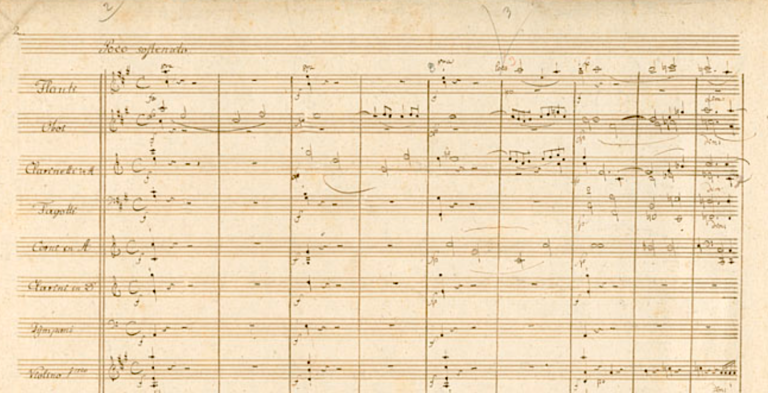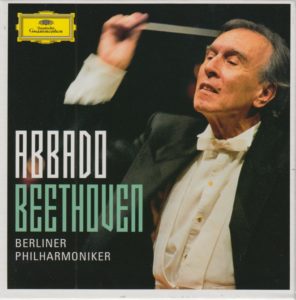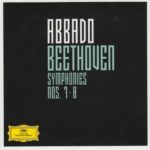
Today, I’m back at the Restaurant-Chain-That-Must-Not-Be-Named – only this time I’m listening to Italian conductor Claudio Abbado (1933-2014), Berliner Philharmoniker, and a new musical selection, Beethoven’s Symphony No. 7 in A Major.
This particular establishment is usually filled with breakfasters and talkers.
Today is no exception.
Also no exception is the average age of the people here – I’d say somewhere around 65-70. I’m not suggesting that’s bad or good. I’m just observing and making a guess.
I’m excited to start a new symphony this morning.

According to its entry on Wikipedia,
The Symphony No. 7 in A major, Op. 92, is a symphony in four movements composed by Ludwig van Beethoven between 1811 and 1812, while improving his health in the Bohemian spa town of Teplice. The work is dedicated to Count Moritz von Fries.
At its premiere, Beethoven was noted as remarking that it was one of his best works. The second movement, Allegretto, was the most popular movement and had to be encored. The instant popularity of the Allegretto resulted in its frequent performance separate from the complete symphony.
The work was premiered with Beethoven himself conducting in Vienna on 8 December 1813 at a charity concert for soldiers wounded in the Battle of Hanau. In Beethoven’s address to the participants, the motives are openly named: “We are moved by nothing but pure patriotism and the joyful sacrifice of our powers for those who have sacrificed so much for us.”
The program also included the patriotic work Wellington’s Victory, exalting the victory of the British over Napoleon’s France. The orchestra was led by Beethoven’s friend Ignaz Schuppanzigh and included some of the finest musicians of the day: violinist Louis Spohr, composers Johann Nepomuk Hummel, Giacomo Meyerbeer and Antonio Salieri, bassoonist Anton Romberg, and the Italian double bass virtuoso Domenico Dragonetti, whom Beethoven described as playing “with great fire and expressive power”. The Italian guitar virtuoso Mauro Giuliani played cello at the premiere.
The piece was very well received, such that the audience demanded the Allegretto movement be encored immediately. Spohr made particular mention of Beethoven’s antics on the rostrum (“as a sforzando occurred, he tore his arms with a great vehemence asunder … at the entrance of a forte he jumped in the air”), and “the friends of Beethoven made arrangements for a repetition of the concert” by which “Beethoven was extricated from his pecuniary difficulties”.
The work was premiered with Beethoven himself conducting in Vienna on 8 December 1813 at a charity concert for soldiers wounded in the Battle of Hanau. In Beethoven’s address to the participants, the motives are openly named: “We are moved by nothing but pure patriotism and the joyful sacrifice of our powers for those who have sacrificed so much for us.”
Critics and listeners have often felt stirred or inspired by the Seventh Symphony. For instance, one program-note author writes:
… the final movement zips along at an irrepressible pace that threatens to sweep the entire orchestra off its feet and around the theater, caught up in the sheer joy of performing one of the most perfect symphonies ever written.
Composer and music author Antony Hopkins says of the symphony:
The Seventh Symphony perhaps more than any of the others gives us a feeling of true spontaneity; the notes seem to fly off the page as we are borne along on a floodtide of inspired invention. Beethoven himself spoke of it fondly as “one of my best works”. Who are we to dispute his judgment?
Another admirer, composer Richard Wagner, referring to the lively rhythms which permeate the work, called it the “apotheosis of the dance”.
A very comprehensive analysis of Beethven’s Seventh can be found on Peter Gutmann’s web site Classical Notes. And, when I write “comprehensive,” I mean it. This is exhaustive. Pay a visit to the site. You’ll be pleased…and overwhelmed.
 I’ve encountered Maestro Abbado six times prior to this morning, on…
I’ve encountered Maestro Abbado six times prior to this morning, on…
Day 1. Rating: None.
Day 19. Rating: “Meh!”
Day 37. Rating: “Meh!”
Day 55. Rating: “Huzzah!”
Day 73. Rating: “Meh!”
Day 91. Rating: “Huzzah!”
 Beethoven wrote his symphonies in four parts (except for the Sixth, which is in five). The time breakdown of this particular one (Symphony No. 7 in A major), from this particular conductor (Abbado, at age 68) and this particular orchestra (Berliner Philharmoniker), at this particular time in history (February 2001) on this particular record label (Deutsche Grammophon) is as follows:
Beethoven wrote his symphonies in four parts (except for the Sixth, which is in five). The time breakdown of this particular one (Symphony No. 7 in A major), from this particular conductor (Abbado, at age 68) and this particular orchestra (Berliner Philharmoniker), at this particular time in history (February 2001) on this particular record label (Deutsche Grammophon) is as follows:
I. Poco sostenuto – Vivace……………………………..13:33
II. Allegretto………………………………………………………7:40
III. Presto – Assai meno presto (trio)……………….8:58
IV. Allegro con brio…………………………………………..8:12
Total running time: 37:43
My Rating:
Recording quality: 5 (sounds flawless to me)
Overall musicianship: 5 (inspired, energetic, magical)
CD liner notes: 4 (liner notes consist of all necessary technical detail, plus an essay about Abbado’s approach to conducting Beethoven, translated into E/G/F/I, but virtually nothing about Beethoven himself or his symphonies)
How does this make me feel: 5 (“Huzzah!”)
What an amazing performance of a stellar symphony!
I remembered what I liked about Beethoven’s Seventh – Movement II, which is possibly my favorite Beethoven in any Beethoven symphony. It’s heart wrenching in its poignancy. Sounds like a funeral dirge, yet not. More akin to the feeling one gets from reading sublime love poems.
Here it is, maybe even the very performance I heard this morning.
Absolutely gorgeous, and moving to the point of causing me to choke up.
Years ago, on one of my musical projects, when I heard this movement I stopped short. I played it through three times. Later that night, I played it for my wife – because beautiful music always requires sharing. For me, anyway.
So this is the movement I will use as my gauge for the rest of the symphonies in this cycle of Beethoven’s Seventh. I will judge all conductors and orchestras based on how their rendition moves me in this one movement.
Overall, I can best describe this symphony by quoting music author Antony Hopkins: “the notes seem to fly off the page as we are borne along on a floodtide of inspired invention.”
That’s how this symphony feels – inspired.
As for this particular performance, it is very well recorded, lush, majestic, fun, and pithy. Lots of dynamic range. The symphony seems as inspired as the source material.
I was hooked from Movement I all the way through to the end. The tempo felt right – reverent but not maudlin. Some passages were downright energetic and uplifting. Movement IV, for example. Sounds like a horse race in full swing, horse and jockey alike sprinting to the end.
This performance is “Huzzah!” all the way.
Highly recommended.
